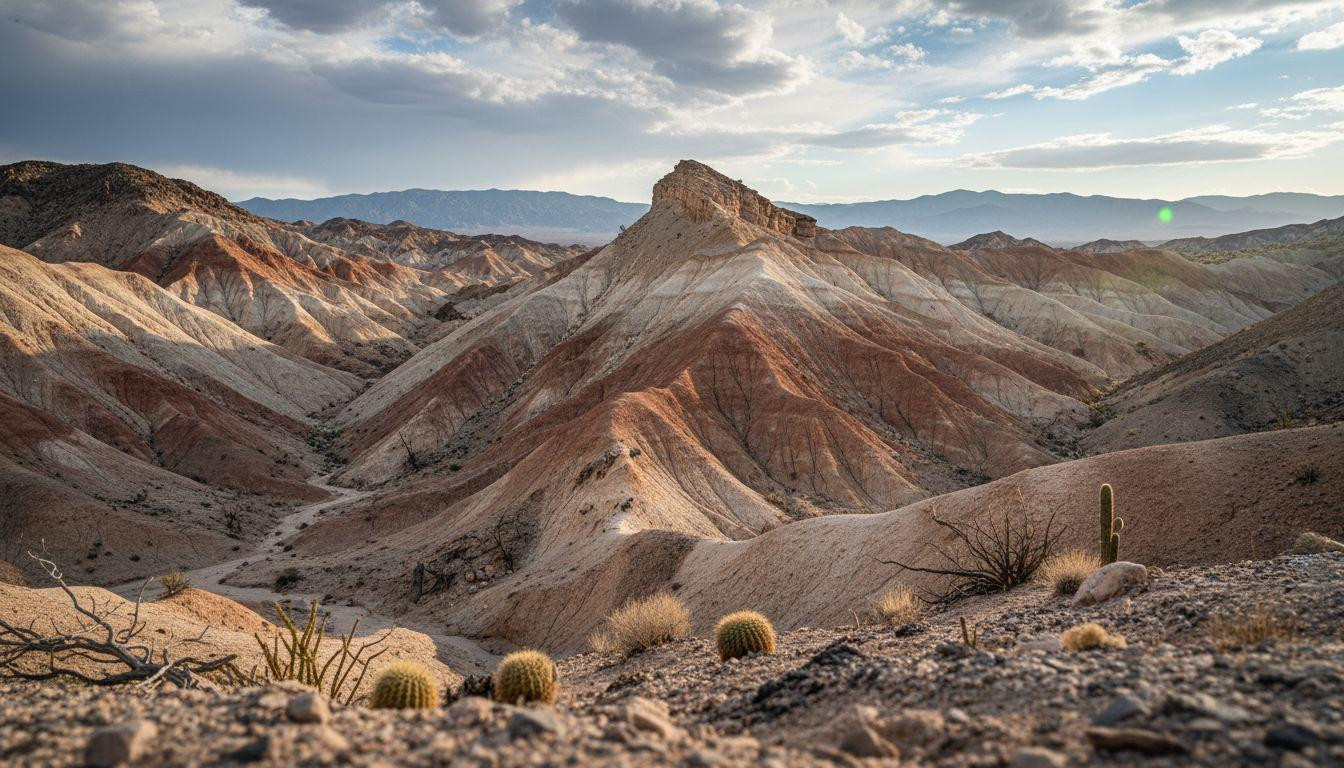Death Valley’s parking lots overflow with tour buses as temperatures soar past 125°F. Entry fees reach $30 per vehicle while visitors queue for hours at Badwater Basin’s salt flats. California’s most famous desert has become a victim of its own success. Just 90 miles east of San Diego, a quieter alternative spreads across 600,000 acres of badlands and wildflower fields. Anza-Borrego Desert State Park delivers the same dramatic landscapes for $10 entry, hosts 20-foot metal sculptures emerging from golden sand, and offers authentic desert solitude without Death Valley’s crowds or extreme heat.
Why Death Valley has become impractical for most travelers
Death Valley’s 1.4 million annual visitors create serious logistical challenges. Summer temperatures reach 125°F, conditions that have killed unprepared tourists. The park’s narrow scenic corridors concentrate crowds at Zabriskie Point and Artist’s Palette, creating traffic jams on desert roads.
Entry costs $30 per vehicle, triple Anza-Borrego’s $10 fee. Prime wildflower viewing now requires advance permits and lottery systems. Distance compounds problems: 150 miles from Las Vegas means most visitors arrive exhausted before exploring begins.
Gas stations charge premium prices while Furnace Creek books months ahead for spring blooms. Death Valley rewards hardcore desert enthusiasts willing to navigate extreme conditions. Most travelers want desert beauty without survival challenges.
Meet Anza-Borrego: Death Valley’s accessible alternative
Landscape drama without the extremes
Anza-Borrego sprawls across 600,000 acres, California’s largest state park. Red badlands rival Death Valley’s Artist’s Palette while slot canyons slice through sandstone cliffs. Palm oases hide in desert washes where bighorn sheep drink at dawn.
The park adds what Death Valley lacks: 130 life-sized metal sculptures by artist Ricardo Breceda. A 20-foot serpent emerges from desert sand near Galleta Meadows. Metal raptors perch on ridgelines while prehistoric creatures tower beside Highway S-22.
These surreal installations transform desert drives into art gallery experiences impossible in federally protected Death Valley. Sunrise and sunset light transforms sculptures into glowing monuments against pristine landscapes.
The proximity and price advantage
Entry costs just $10 per vehicle, 67% less than Death Valley’s $30 fee. The park sits 90 miles from San Diego, 130 miles from Los Angeles. No multi-hour desert drives required through empty Nevada.
You can breakfast in coastal San Diego, photograph wildflowers by 11 AM, and return for seafood dinner. This proximity makes impossible day trips from Death Valley suddenly feasible from Southern California’s major cities.
What you’ll experience at Anza-Borrego
Wildflower displays without permits
February through April brings desert wildflower displays rivaling Death Valley’s legendary blooms. Parish’s goldpoppy carpets valleys in orange waves while desert sunflowers explode across hillsides. No lottery systems or advance permits required.
The park’s varied elevations from 200 to 6,000 feet extend flowering seasons across three months. According to California State Parks data, Anza-Borrego received less than one inch of rain this winter, well below the 5.5-inch average that produces spectacular blooms.
Even modest years deliver wildflower patches Death Valley struggles to match. Local tourism boards confirm that elevation diversity creates reliable color somewhere in the park.
Art treasure hunt in the desert
Breceda’s 130 sculptures turn desert exploration into artistic discovery. No entrance fees or guided tours required, just drive Highway S-22 watching for metal silhouettes against sky. Dawn light transforms serpents and scorpions into dramatic monuments.
Recent visitor surveys reveal these installations rank as top photography destinations. Travelers consistently describe finding sculptures as “unexpected magic” that Death Valley’s geological focus cannot replicate.
The comfortable desert experience
Summer temperatures peak at 110°F, not Death Valley’s deadly 125°F. Winter highs reach pleasant 70°F while desert silence amplifies the International Dark-Sky Association’s pristine night skies. Milky Way arcs overhead with zero light pollution.
Borrego Springs (population 3,429) offers accommodations from $80 camping to $500 luxury resorts. Total costs run 40% below Death Valley’s inflated prices. Meals average $15-30 versus Death Valley’s $25-50 resort dining.
The park stays open year-round without Death Valley’s seasonal road closures. No reservation systems complicate spontaneous desert exploration.
Your questions about Anza-Borrego Desert State Park answered
When should I visit for the best wildflower displays?
February through April offers peak wildflower viewing, though 2025’s below-average rainfall created modest blooms. Check the Anza-Borrego Foundation’s bloom reports for real-time updates on Parish’s goldpoppy and desert sunflower displays across different elevation zones.
How do the metal sculptures compare to Death Valley’s attractions?
Ricardo Breceda’s 130 installations provide unique photo opportunities impossible in Death Valley’s federally protected landscape. The sculptures concentrate around Galleta Meadows and Highway S-22, accessible by regular vehicles without hiking requirements.
What makes Anza-Borrego better than Death Valley for families?
Safer summer temperatures (110°F versus 125°F), closer proximity to San Diego (90 versus 150 miles), and 67% lower entry costs ($10 versus $30) make family desert exploration more practical and affordable.
Metal raptors catch sunset light on ridgelines as desert silence stretches forever. This is the authentic desert experience Death Valley offered before crowds and heat extremes complicated everything. Here, solitude still exists at 600,000 acres where art meets wilderness.
